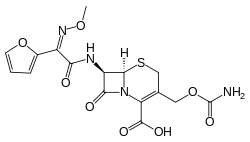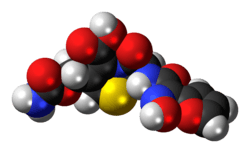Cefuroxime
 | |
 | |
| Clinical data | |
|---|---|
| Trade names | Zinacef, Ceftin |
| MedlinePlus | a601206 |
| Pregnancy category |
|
| Routes of administration | Intramuscular, intravenous, oral |
| ATC code | |
| Legal status | |
| Legal status |
|
| Pharmacokinetic data | |
| Bioavailability | 37% on an empty stomach, up to 52% if taken after food |
| Elimination half-life | 80 minutes |
| Excretion | Urine 66–100% unchanged |
| Identifiers | |
| |
| CAS Number | |
| PubChem CID | |
| DrugBank | |
| ChemSpider | |
| UNII | |
| KEGG | |
| ChEMBL | |
| ECHA InfoCard |
100.054.127 |
| Chemical and physical data | |
| Formula | C16H16N4O8S |
| Molar mass | 424.38 g·mol−1 |
| 3D model (JSmol) | |
| |
| |
| (verify) | |
Cefuroxime is an enteral second-generation cephalosporin antibiotic. It was discovered by Glaxo, now GlaxoSmithKline, and first marketed in 1978 as Zinacef. It received approval from the U.S. Food and Drug Administration in October 1983.[1]
Cefuroxime axetil is an acetoxyethyl ester prodrug of cefuroxime which is effective orally.[2]
Medical uses
As with the other cephalosporins, it is susceptible to beta-lactamase, although as a second-generation variety, it is less so. Hence, it may have greater activity against Haemophilus influenzae, Neisseria gonorrhoeae, and Lyme disease. Unlike most other second-generation cephalosporins, cefuroxime can cross the blood-brain barrier.
A systematic review found high quality evidence that injecting the eye with cefuroxime after cataract surgery will lower the chance of developing endophthalmitis after surgery.[3]
Side effects
Cefuroxime is generally well-tolerated and its side effects are usually transient. If ingested after food, this antibiotic is both better absorbed and less likely to cause its most common side effects of diarrhea, nausea, vomiting, headaches/migraines, dizziness, and abdominal pain compared to most antibiotics in its class.
Although a widely stated cross-allergic risk of about 10% exists between cephalosporins and penicillin, recent assessments have shown no increased risk for a cross-allergic reaction for cefuroxime and several other second-generation or later cephalosporins.[4]
Trade names
In US it is available as Zinacef by Covis Pharmaceuticals as the company acquired the US rights of the product from GSK.[5] GSK had continued marketing a pediatric oral suspension as Ceftin; however, this presentation was discontinued as of June 24, 2017.[6]
In Bangladesh it is available as Kilbac by Incepta and Xorimax by Sandoz. In India it is available as Ceftum in tablet form and Supacef in injection form by GSK.[7] In Poland it is available as Zamur by Mepha, subsidiary of Teva Pharmaceutical Industries.[8] In Australia, the "first generic" form of Cefuroxime axetil, Pharmacor Cefuroxime (tablets) from Pharmacor Pty Ltd, was registered on 27 March 2017 by the Therapeutic Goods Administration.[9] Cefuroxime axetil is also available (in two strengths) as granules for oral suspension from Aspen Pharmacare Australia Pty Ltd under the brand name Zinnat cefuroxime.[10]
References
- ↑ "Cefuroxime medical facts from". Drugs.com.
- ↑ Walter Sneader. "Drug Discovery: History".
- ↑ Gower EW, Lindsley K, Tulenko SE, Nanji AA, Leyngold I, McDonnell PJ (2017). "Perioperative antibiotics for prevention of acute endophthalmitis after cataract surgery". Cochrane Database Syst Rev. 2: CD006364. doi:10.1002/14651858.CD006364.pub3. PMC 5375161. PMID 28192644.
- ↑ Pichichero ME (2006). "Cephalosporins can be prescribed safely for penicillin-allergic patients" (PDF). The Journal of family practice. 55 (2): 106–12. PMID 16451776. Archived from the original (PDF) on 24 February 2012.
- ↑ http://www.covispharma.ch/assets/pdf/covis-pharma-acquires-portfolio-of-drugs-from-glaxosmithkline.pdf
- ↑ "FDA Drug Shortages". www.accessdata.fda.gov.
- ↑ "GlaxoSmithKline Pharmaceuticals Limited – Prescription Medicines – Anti-Infective". Gsk-india.com. 26 March 2013.
- ↑ "Charakterystyka produktu lecznicznego" (PDF). Urząd Rejestracji Produktów Leczniczych, Wyrobów Medycznych i Produktów Biobójczych. 12 November 2015.
- ↑ "Prescription medicines: registration of new generic medicines and biosimilar medicines, 2017". TGA. Therapeutic Goods Administration. Retrieved 30 July 2018.
- ↑ "ARTG ID 81301". TGA. Therapeutic Goods Administration. Retrieved 30 July 2018.